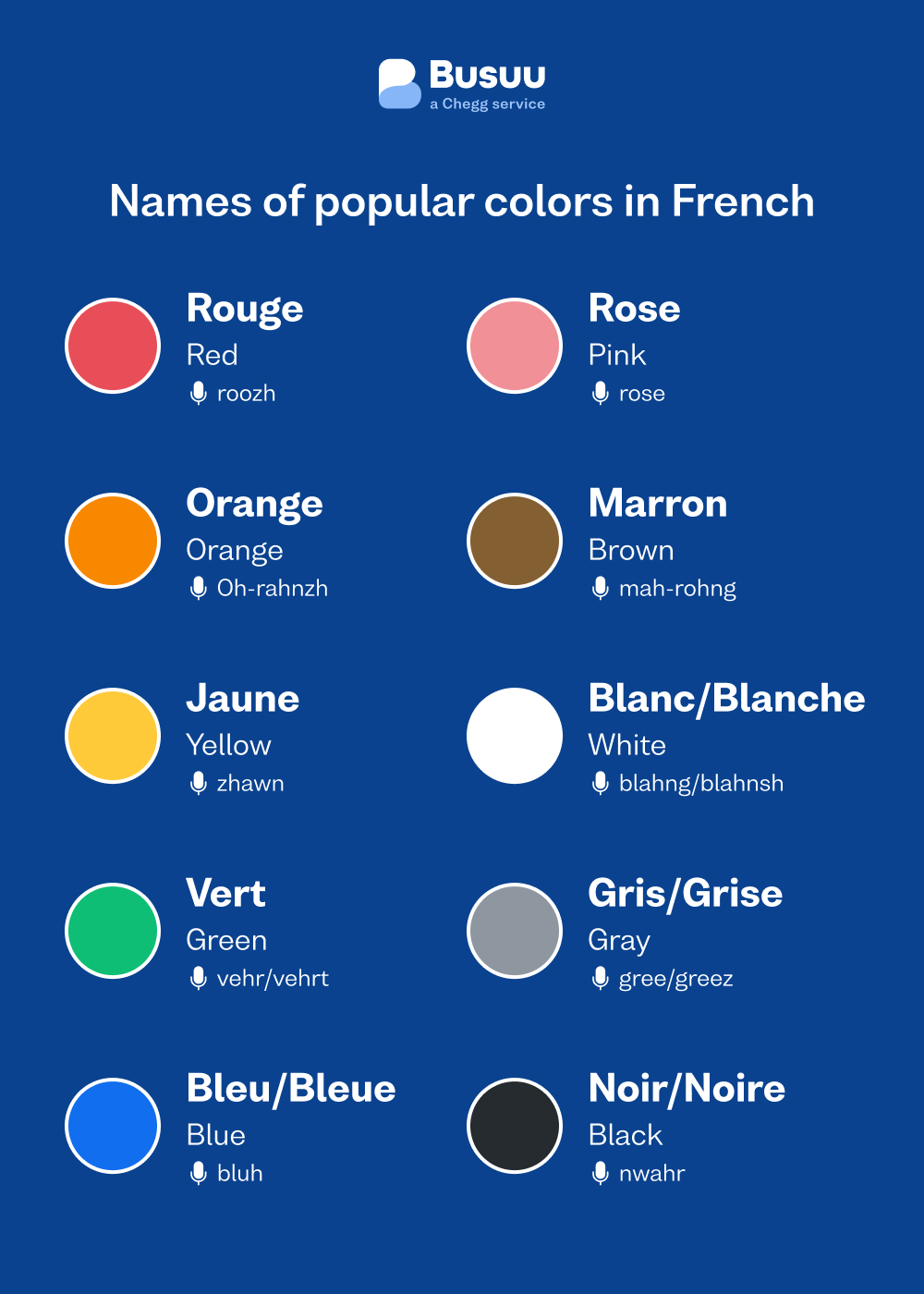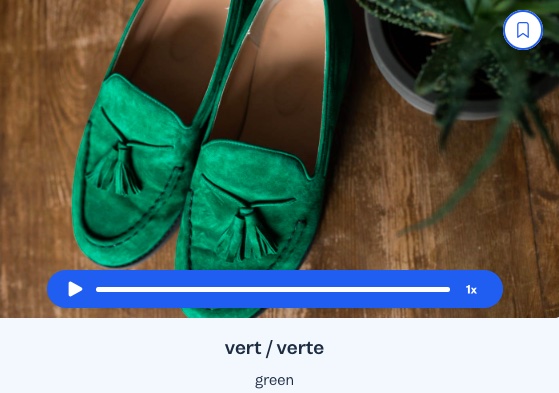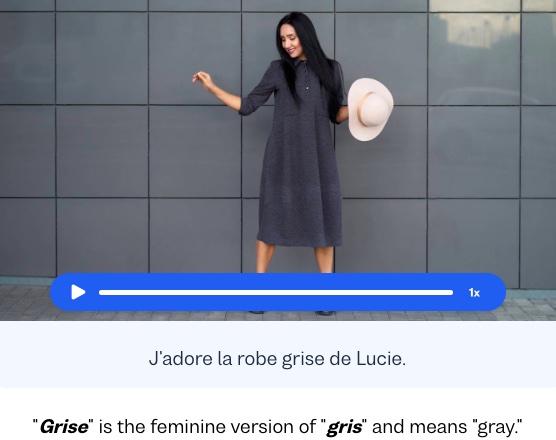Learn the Colors in French
Get to know these top 10 commonly used French colors and practice pronouncing and using them.
I want to learn...
Do you know which is the most popular color in the world? Which colors will you find in the French flag?
We’ll answer these questions and more in this guide to learning how to talk and write different colors in French.
Colors are very important language descriptors, which we use in everyday conversations in all languages.
Colors add detail to our interactions, they help us differentiate objects, emotions and physical characteristics. In short, we talk about color more than you might realize.
This means when you’re learning a new language, colors are one of the first groups of adjectives you learn. How do you say different colors in French?
Unlike English where color names are fixed, in French it is a little more nuanced.
French adjectives change to agree with both the gender and the number of the noun they modify, which means there can be up to four forms of each adjective, and colors are no exception.
Colors in French
| English color | French color | French Pronunciation |
|---|---|---|
| Blue | Bleu/Bleue | bluh |
| White | Blanc/Blanche | blahng/blahnsh |
| Red | Rouge | roozh |
| Yellow | Jaune | zhawn |
| Green | Vert/Verte | vehr/vehrt |
| Orange | Orange | Oh-rahnzh |
| Brown | Marron | mah-rohng |
| Pink | Rose | rose |
| Black | Noir/Noire | nwahr |
| Grey | Gris/Grise | gree/greez |

What is the most popular color in the world?
Blue - le bleu
Blue is the most popular color across the world. It is often associated with sadness, or as a cold color, but it is also the color we all look for on a sunny day with a clear blue sky. For French people, blue also represents national sports teams. You might have heard the expression “Allez les bleus” to cheer on the French national football and rugby teams.
Shades of blue
There is of course, more than one blue, so in French, as with English, you can describe the shade of blue with additional adjectives. For example:
- bleu clair (light blue)
- bleu foncé (dark blue)
Clair and foncé can also be added to all the other colors in French.
In French, the adjective blue changes its form to agree with the gender and number of the object or objects in the sentence - although the pronunciation stays the same for all 4 forms.
Singular and plural versions of the color blue
| Bleu | Singular | Plural |
|---|---|---|
| Masculine | Bleu | Bleus |
| Feminine | Bleue | Bleues |
For example:
- Aujourd'hui il y a un ciel bleu magnifique - Today there is a beautiful blue sky.
- Marie a les yeux bleus - Mary has blue eyes.
- Vue de l’espace, la planète Terre apparaît toute bleue - In space, the planet Earth appears to be all blue.
- Ces filles portent des robes bleues - These girls wear blue dresses.
White - le blanc
White is synonymous with peace and clarity, and is one of the three colors in the French flag, along with blue and red.
The three colors in the modern French flag each have meaning, blue and red represent Paris, while the white is the color of the king.
Singular and plural versions of the color white
| Blanc | Singular | Plural |
|---|---|---|
| Masculine | Blanc | Blancs |
| Feminine | Blanche | Blanches |
The adjective blanc also changes its form to agree with the gender and number of the object in question.
For example:
- Je n'ai pas vu le mur blanc (I didn't see the white wall).
- La Maison Blanche (The White House).
- Les flocons sont blancs (The flakes are white).
- Ces filles portent des robes blanches (These girls are wearing white dresses).
Red - le rouge
The color red is associated with a number of emotions, some French examples include:
- Être rouge de colère means to be red with anger.
- The verb rougir means to blush.
Rouge doesn’t change to agree with the gender of the object in question, only the number:
Singular and plural versions of the color red
| Rouge | Singular | Plural |
|---|---|---|
| Masculine | Rouge | Rouges |
| Feminine | Rouge | Rouges |
It’s also worth noting that rouge is always pronounced the same regardless of gender and number.
For example:
- Mars est la planète rouge (Mars is the red planet).
- Les camions de pompiers sont rouges (Fire trucks are red).
Yellow - le jaune
Just like rouge, the adjective jaune only changes its form to agree with the number of the object in question. In addition, the ‘s’ when pluralizing, is silent:
Singular and plural versions of the color yellow
| Jaune | Singular | Plural |
|---|---|---|
| Masculine | Jaune | Jaunes |
| Feminine | Jaune | Jaunes |
For examples:
- J'ai un T-shirt jaune (I have a yellow t-shirt).
- Les tournesols sont jaunes (Sunflowers are yellow).
Green - le vert
Green is the color of life and nature, and is the second most popular color in the world.
In French, the adjective vert changes its form to agree with both the gender and the number of the objects in question:
Singular and plural versions of the color green
| Vert | Singular | Plural |
|---|---|---|
| Masculine | Vert | Verts |
| Feminine | Verte | Vertes |
For example:
- Elle a commandé un thé vert (She ordered a green tea).
- Elle a une robe verte (She has a green dress).
- J'ai des pantalons verts (I have green pants).
- Les plantes sont vertes (The plants are green).
Orange - l’orange
Let’s settle this debate, the fruit came first. Orange the color was named because that was the color of the fruit and not the other way around. And, it's the same word in English, so it's easy to remember.
Important note: In French the adjective orange does not agree with the gender and/or number of the object in question, because it is derived from a noun of another object.
For example: J'adore les tulipes orange (I love orange tulips).
Brown - le marron
Brown is the color of the earth, soil, and wood. The French word marron comes from the name of a fruit - le marron (the chestnut). Unlike other color adjectives, marron does not change its form. Unlike some other color adjectives but similar to orange, marron does not change its form.
For example:
- Il a des yeux marron (He has brown eyes).
- La table et la chaise sont marron (The table and the chair are brown).
Pink - le rose
In French, the color rose, and the flower rose, shouldn’t be confused. Le rose, is the color, whereas la rose is the flower. The adjective rose changes its form to agree with the number in question, and when plural, the ‘s’ is not pronounced:
Singular and plural versions of the color rose
| Rose | Singular | Plural |
|---|---|---|
| Masculine | Rose | Roses |
| Feminine | Rose | Roses |
The rule that colors which derive from nouns don’t change their form, which applies to orange and marron does not apply here. Rose is an exception.
For example:
- J'ai acheté une chemise rose (I bought a pink shirt).
- J'ai acheté des lunettes roses. (I bought pink glasses.)
Black - le noir
Black is a very popular color in fashion. "La petite robe noire", known in English as the little black dress, has origins that go back to the 1920s from French designer Coco Chanel. There are many French expressions featuring the word black: le trou noir, le chocolat noir, etc.
The adjective noir does change its form to agree with the gender and number in question, but the pronunciation always stays the same:
Singular and plural versions of the color black
| Noir | Singular | Plural |
|---|---|---|
| Masculine | Noir | Noirs |
| Feminine | Noire | Noires |
For example:
- Tu as vu le cheval noir. (Have you seen the black horse?).
- Ma voiture est noire (My car is black).
- Il y a des corbeaux noirs dehors (There are black crows outside).
- Elles portent des robes noires.
Grey - le gris
While grey is a neutral color, it’s also very stylish. “Better grey than garishness” said Jean-Auguste-Dominique Ingres, a French Neoclassical painter.
The adjective gris also changes its form to agree with the gender and number in question, but it is only the feminine that changes:
Singular and plural versions of the color grey
| Gris | Singular | Plural |
|---|---|---|
| Masculine | Gris | Gris |
| Feminine | Grise | Grises |
For example:
- Ses cheveux sont gris. (His hair is grey.)
- Elles portent des robes grises (They wear grey dresses).
Top tips for learning French colors
- The pronunciation does not change according to the change of form.
- The color comes after the noun, unlike in English. Eg: une chemise rouge instead of a red shirt.
- Colors cannot be reduced to a list of vocabulary because you have to take into account the gender (feminine/masculine) and number (singular/plural) of the object in question.
Ready for more French?
With Busuu, you’ll learn the everyday French you’ll really use, from travel vocabulary, conversation starters, phrases to use at work, and lots more, whatever your current language knowledge.

